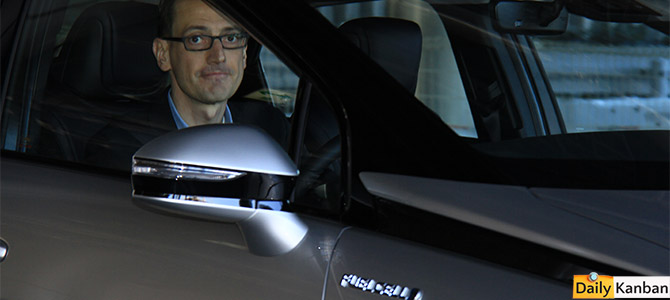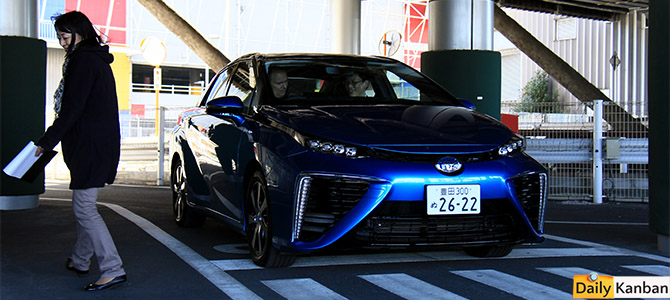Having been in far too many nearly finished cars in a former life, I don’t get excited by test drives. Nevertheless, I always go when invited. While other journalists drive the car, I shoot the breeze with the engineers who make the car. It is amazing what you can absorb while not driving at these test drives. Today for instance, I learn that the new fuel cell Toyota Mirai looks the way it looks, because the man in charge was sick of the Prius.
I am in the basement garage of Toyota’s Megaweb in Tokyo, and while the A-list of Tokyo’s automotive press corps takes a very blue, and a senior-silver Mirai through a very closed course outside, I chew, a paper cup with hotto kohee in my hands, the fat with the gentlemen who made the Mirai happen.
“I was responsible for the third generation Prius, and I was getting tired of it,” the Mirai’s project manager Toshihiro Kasai quips after he is asked why the hydrogen power-train was not simply another bullet on the option list of Toyota’s best-selling hybrid. After quickly adding that he was joking, Kasai says that the Mirai slots above the Prius, that a “higher class car must be a sedan, not a hatchback,” and that the car isn’t so expensive, because it is a premium car. It is sold as a premium car, because it still is very expensive.
But wait: At JPY 7,236,000 (USD 62,000) including consumption tax in Japan, the Mirai is the lowest priced of the available fuel cell cars. A Dutch journalist, done driving and obviously on a huge expense account, calls the Mirai “amazingly cheap,” and asks repeatedly why it costs “half of the Hyundai FCV.” Each time, the assembled Toyota folks overhear the question. They all agree that in the future, that price has to come way down.
“7 million yen is very high,” offers Yoshikazu Tanaka, Deputy Chief Engineer of the Mirai. “Our aim is to bring the price much lower. Eco cars need volume to make a difference, and if the price is high, people won’t buy them.” Nods around the table.
How much cheaper? Toyota aims to bring its in-house cost of the fuel cell powertrain down to “one third of the current level within 5 to 6 years,” chimes in Yashuhiro Nonobe, the General Manager of the Fuel Cell System Design Dept. at Toyota. He also tells me that the water that comes out of the Mirai is fit to drink “if you run it through a filter. After all, this is how the Apollo astronauts got their water.” I get another hotto kohee.
Tanaka sits next to me, and I show him the alleged investment advice of The Motley Fool, where its senior auto specialist John Rosevear writes that “Toyota’s hydrogen car is a giant bluff,” and a stopgap measure to bide time, that Toyota is counting on Tesla “to help it out with electric-car development,’ and that both of them will crank out BEVs by the bazillions together, eventually, call your broker, buy TSLA.
“This is totally incorrect,” proclaims the Deputy Engineer, and a wave of “so desu ne” rolls around the table. Then, Tanaka launches into the most forceful damnation of the BEV since his boss and Toyota Chairman Takeshi Uchiyamada said that “the current capabilities of electric vehicles do not meet society’s needs, whether it may be the distance the cars can run, or the costs, or how it takes a long time to charge.” Says Tanaka, and it is pretty clear where this remark is directed:
“People say the driving range is the biggest difficulty with EVs. Personally, I think that the biggest problem is the long charging time. Range can be extended by carrying enough batteries. But then, it takes progressively longer to charge. Even with a quickcharger, a car with that range would need 40 to 50 minutes.”
Toyota knows its customers. Once you market cars beyond the small demographic of faith-based car buyers, you know that practicality, ease of use and convenience drive volume. Even a 30 minute wait for a refuel is too long for most. A Hydrogen car can be refueled as quickly as a conventional one. If Mr. Rosevear would be sitting around our table, listening how engineers and product planners talk about selling “a few ten thousand” by 2020, a milestone needed to hit “serious volume by 2030-40,” Rosevear would agree that Toyota isn’t bluffing.
More journalists should be able to grab a hotto kohee, and sit around this table. Mark Kane of Inside EVs would have loved to be here. Noting the curb weight of the Mirai (1,850 kg / 4,079 lbs), Kane deduced “that fuel cells don’t have a weight advantage over EVs.“ Amazingly, Kane would have received a “so desu ne” today.
“We do think that the car is heavy,” project manager Kasai nods. “The weight of the fuel cell system, the stack, the tank, and all kinds of different parts that come with it are not as light as we want them to be.” In future generations, not just the price of the fuel cell system will come down considerably. Weight and size have to go down as well. Already, the package size of the system fits a Corolla or a Yaris, but it will shed more inches and lbs.
Currently, Toyota’s fuel cell stack weighs 56 kg (123.5 lbs), while the CFRP hydrogen tanks add 192.9 lbs (87.5 kg) to the scale. According to Kasai, that is not the sole reason for the FCV’s heft. Additions to the body that provide extra support also are a weight factor.
Still, Kasai adamantly maintains that fuel cells have a huge weight advantage over batteries. “Powered by a battery instead of a fuel cell, a car with that range would be much, much heavier,” Kasai says. The Model S, loaded to the gills with heavy batteries, weighs more than the Mirai, and it won’t get as far.
With all the talk of the established auto industry being disrupted by Silicon Valley mavericks, today I am beginning to believe that the disruption might go the other way. When Standard & Poors worried that Tesla “is less likely to successfully adapt to competitive and technological displacement risks over the medium to long term,” this is what was on their minds. Price, range, recharge time, and a lack of infrastructure supposedly stand in the way of wholesale adoption of the electric vehicle. An FCV is an EV, just with a fuel cell instead of a battery. Making the fuel cell is not rocket science, it is much harder. The range of the FCV is that of a conventional car. The FCV can be refueled as fast as a conventional car. The price of a Mirai already is half of a high-end Tesla, and Toyota’s engineers at the table swear that it will come down a lot. This hard-to-engineer stuff scales way better than batteries.
Remains infrastructure. This is where Yoshikazu Tanaka, the Deputy Chief Engineer, gets philosophical:
“We need more cars before the infrastructure is established, and we need the infrastructure before the car is beginning to sell. All we can do is provide better cars. Right?”
He looks around the table. Nobody objects, but nobody provides a brilliant idea either to break the chicken & egg logjam. The test drives outside are completed. We all get up and back to work.
PS: I drove the car after all. It drives great, and it provides the oomph expected from 335 Nm (247 pounds-feet) of torque. If you have driven a Prius, you will feel right at home behind the wheel. You will miss the roar of the engine. Toyota’s Dion Corbett and I searched for adequate words to describe the auto’s audio, and we finally agreed that when revved, the engine sounds “like a nonplussed cat.”









